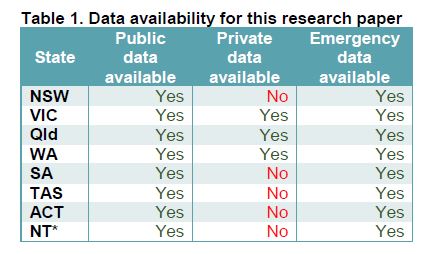With just weeks to the deadline for its Final Report, the Royal Commission keeps on delivering.
Its 18th 30-page research paper, ‘Hospitalisations in Australian Aged Care: 2014/15–2018/19’ is the first time aged care hospitalisation rates have been calculated at a national level according to the Commission.
Some private hospital data not available – even with Royal Commission’s powers
 The paper reveals that 36.9% of aged care residents presented to an emergency department at least once in 2018-19 (up to 37% when private hospital admissions were included), up from 32.7% in 2014-15 – many for preventable incidents.
The paper reveals that 36.9% of aged care residents presented to an emergency department at least once in 2018-19 (up to 37% when private hospital admissions were included), up from 32.7% in 2014-15 – many for preventable incidents.
Private hospital data for a number of states was still missing despite the broad powers of the Commission to compel information (see the table).
However, of the emergency presentations for which there was data was available, 10.5% of residents were hospitalised for a fall; 5.4% for a fracture; 3.4% with a pressure injury; 1.9% with weight loss or malnutrition; and 0.5% for an adverse medication event.
Public hospital admissions sitting at 30% for aged care residents
Similarly, the public hospital admission rate in 2018/19 was 30.7% for the states where data for private hospitals was available – very slightly lower than for Australia as a whole – while 9.4% of residents had a private hospital admission.
Overall, the most common reasons for hospital admissions and emergency department presentations were respiratory disease, injuries, circulatory disease, dialysis, and ‘symptoms and signs’ (i.e., staff presumably realising that Mrs Smith was not her usual self and calling it in).
The data also shows that while over-65s in residential care had lower hospitalisation rates than their peers in the community, their emergency department admissions were much higher – 938 per 1,000 compared to 671 per 1,000.
Some facilities more likely to have higher rates of pressure sores, weight loss and adverse medication events
Residents were frequently re-admitted too – in 2018/19, 22.2% of residents returning to, or entering, permanent residential aged care from an overnight hospital stay re-presented to the emergency department within 30 days.
Critically, the report finds a number of facilities where residents had significantly higher rates of hospital admissions for pressure injuries, weight loss, or adverse medication events.
These facilities are not identified – and of course, emergency department admissions are not the only indicator of quality of care.
But the Royal Commission notes that this information could be used to help consumers choose between aged care services, assist the regulator to address non-compliance, and enable providers to continually improve their services.
Royal Commission says better data sharing arrangements needed between Governments – and for consumers
The paper also notes that the Government would find it harder to analyse the same data because of the difficulty in accessing information from the States and private hospitals.
“The journey is more challenging because approval is required from each data-holding organisation and the work must be done in accordance with their legislation, policies, practices and timeframes,” they write. “Hospitalisation indicators could be facilitated more effectively in the future if enduring agreements were established by the Australian, State and Territory Health departments to allow data to be shared, linked and analysed.”
The inference is clear – there should be better integration between the Federal-run aged care and State-run hospital systems with data collected routinely and made publicly available to consumers and their families.
Expect to see this make a mention in the Final Report then.










